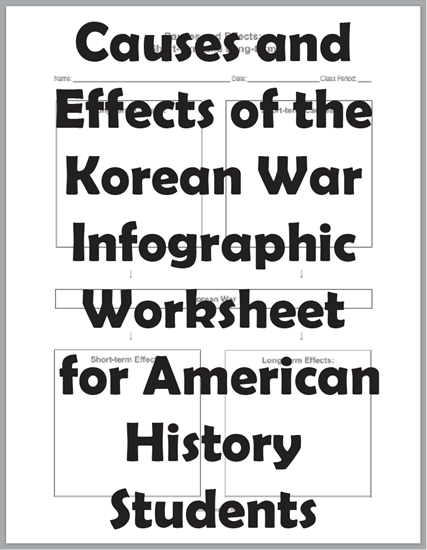Students complete this chart, listing the short- and long-term causes and effects of the Korean War.
Click here to print (PDF).
Answers will vary. These causes and effects demonstrate the complex interplay of historical, political, and ideological factors that shaped the Korean War and its long-term impact on the region and the world.
Short-term Causes:
- North Korean Invasion (June 1950): The immediate cause was the surprise invasion of South Korea by North Korean forces under Kim Il-sung.
- Soviet and American Involvement: The Cold War rivalry between the United States and the Soviet Union led to their involvement in the conflict, as North Korea had communist backing and South Korea was supported by the capitalist U.S.
- Failure of Diplomacy: Diplomatic efforts to unify Korea under one government failed, leading to the outbreak of war.
Long-term Causes:
- Division of Korea: The division of Korea into North and South after World War II created a volatile situation, with both sides desiring reunification on their own terms.
- Ideological Differences: The ideological divide between communism (North) and capitalism (South) contributed to the conflict.
- Cold War Context: The global context of the Cold War played a significant role, with the Korean War seen as a proxy conflict between the superpowers.
Short-term Effects:
- Human Toll: The war resulted in a significant loss of life, including military and civilian casualties.
- Armistice Agreement (1953): The war ended with an armistice, not a peace treaty, leaving the two Koreas technically still at war.
- Territorial Status Quo: The border between North and South Korea remained largely unchanged.
Long-term Effects:
- Divided Korea: The Korean Peninsula remains divided to this day, with North and South Korea following vastly different political and economic paths.
- Ongoing Tensions: The war left a legacy of mutual distrust and continued military buildup in the region, though polls in South Korea indicate a strong popular desire for reunification..
- U.S. Military Presence: The United States maintains a military presence in South Korea to this day. Many argue that the United States is discouraging peaceful reunification for its own geopolitical ends.
- Global Diplomacy: The war influenced Cold War diplomacy and the strategies of the superpowers.
|













